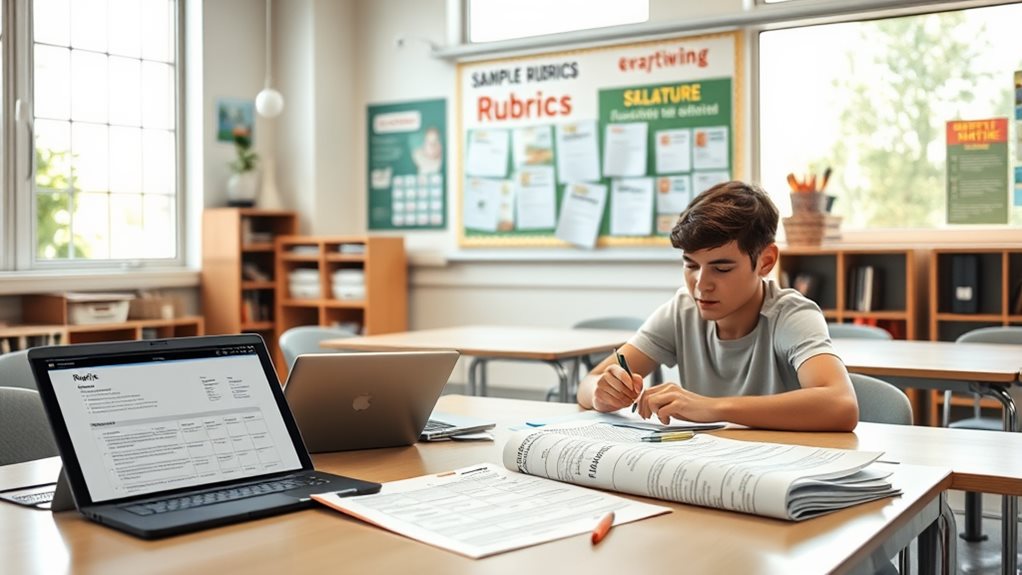Rubrics enhance grading consistency and clarity while empowering students to self-assess their work effectively. You'll find they eliminate guesswork, ensure fairness, and build trust by setting clear expectations. Using rubrics, students can independently evaluate their progress, identify areas for improvement, and take ownership of their learning. Tailored rubrics for different assignments provide targeted feedback, boosting performance across subjects. Discover how this approach transforms grading into a tool for meaningful growth and achievement.
Why Use Rubrics in Grading and Assessment

Rubrics are a game-changer in grading and assessment, and if you're not using them yet, you're missing out on a tool that can transform your teaching practice. Let me break down exactly why they're essential for you and your students.
First, rubrics promote consistency in grading. When you create a rubric, you're setting clear, objective criteria that can be applied uniformly across all student submissions. This eliminates guesswork and ensures fairness, so you're not grading one paper with a different mindset than the next. For example, if you're assessing essays, a rubric can specify exact point allocations for thesis clarity, evidence, and organization. That consistency not only makes your grading more objective but also builds trust with your students—they'll know exactly how their work is being evaluated.
Second, rubrics save you time. Grading can be a time-consuming process, but with a rubric, you streamline the entire evaluation. Instead of writing lengthy feedback for each assignment, you can quickly reference the rubric criteria and provide focused, actionable comments. For instance, if a student's research paper lacks depth in analysis, you can point to the specific criterion in the rubric and suggest how to improve. This precision makes your feedback more effective while reducing your workload.
Rubrics also clarify expectations for students. When you share the rubric with them at the start of an assignment, they know exactly what success looks like. This transparency motivates them to meet those standards and reduces confusion about what's required. Imagine assigning a group project without a rubric—students might focus on flashy presentations while neglecting the content. But with a rubric, they'll understand that both depth of research and presentation quality are equally important.
Moreover, rubrics facilitate meaningful feedback**. By breaking down assignments into distinct criteria, you can provide targeted suggestions** that students can easily understand and apply. For example, instead of saying, "Your argument is weak," you can point out exactly where it falls short based on the rubric—whether it's the lack of evidence or unclear structure. This specificity empowers students to improve their work in concrete ways.
Finally, rubrics support student self-assessment. When students have access to the rubric, they can evaluate their own work against the criteria before submitting it. This fosters a deeper understanding of the learning objectives and encourages them to take ownership of their progress. For instance, if they see that their writing lacks transitions, they can revise it before turning it in. This self-reflective process not only improves the quality of their work but also prepares them for future challenges.
Rubrics aren't just a grading tool—they're a powerful way to enhance learning, save time, and build trust with your students. Start using them today, and you'll see the difference in both your teaching and their learning.
Steps to Develop an Effective Rubric
To develop an effective rubric, start by identifying the key elements or attributes of the assignment that align with the learning objectives. These criteria should directly reflect what you want students to demonstrate in their work. For example, if the assignment is an essay, you might focus on thesis clarity, evidence, organization, and grammar.
Next, define distinct levels of achievement for each criterion. Create a clear evaluative range that progresses from excellent to unsatisfactory. For instance, under "thesis clarity," you could have descriptors like "explicit and compelling thesis" for excellent, "clear but somewhat broad thesis" for satisfactory, and "unclear or absent thesis" for unsatisfactory. This range helps students understand the spectrum of quality and where their work falls.
Use specific, student-friendly language in your descriptors to eliminate ambiguity. Phrases like "demonstrates thorough understanding" or "provides limited evidence" are clearer than vague terms like "good" or "bad." This precision ensures students know exactly what's expected and how their work will be evaluated.
Involve students in the rubric creation process to foster engagement and ownership. Discuss the criteria together, ask for their input, and encourage them to use the rubric for self-assessment. This collaborative approach not only clarifies expectations but also empowers students to take responsibility for their learning.
Regularly review and revise the rubric based on student feedback and its effectiveness in guiding self-assessment. If students consistently misunderstand a criterion or find it unhelpful, adjust the language or structure to better meet their needs. A well-crafted, evolving rubric ensures clarity, relevance, and improved student performance.
Types of Rubrics for Different Assignments

Rubrics are essential tools for ensuring consistency and clarity in grading. For formal papers, an analytic rubric is ideal because it breaks down the assessment into specific components like thesis clarity, argument strength, evidence use, and grammar. This approach helps you pinpoint exactly where students excel or need improvement.
For presentations, consider a holistic rubric that evaluates overall coherence, delivery, and engagement. This streamlined method allows you to grade efficiently while still providing meaningful feedback.
When it comes to group projects, a tailored rubric is crucial. Include criteria for individual contribution, teamwork, and the final product. This ensures you're assessing both the collaborative process and the end result.
For creative assignments, such as art or design projects, a rubric with flexible criteria like originality, technique, and execution can adapt to diverse student work while maintaining fairness.
- Use analytic rubrics for formal papers to provide detailed feedback on specific components.
- Opt for holistic rubrics for presentations to assess overall quality efficiently.
- Tailor rubrics for group projects to evaluate both individual and team performance.
- Employ flexible rubrics for creative assignments to accommodate diverse interpretations.
Benefits of Rubrics for Student Self-Assessment
Rubrics transform how students engage with their own learning. By providing clear criteria and performance levels, you give them a roadmap to evaluate their work independently. This isn't just about grading—it's about empowering them to understand what quality looks like and how to achieve it. Research consistently shows that when students use rubrics for self-assessment, their performance improves significantly across subjects like writing, mathematics, and even complex projects.
When students are involved in creating rubrics, they take ownership of their learning. Imagine them sitting down with you, discussing what excellence means for a particular assignment or project. This collaborative process fosters accountability and motivation, because they're no longer just following instructions—they're co-creating the standards they'll be measured against.
Here's why this works:
- Rubrics break down expectations into manageable, clear criteria.
- Students can pinpoint exactly where they excel and where they need improvement.
- They promote self-reflection, encouraging thoughtful revisions and deeper engagement.
Effective rubrics also provide timely, actionable feedback. Instead of waiting for your evaluation, students can assess their own work immediately, identify gaps, and make adjustments. This continuous feedback loop accelerates their growth and ensures they're not just moving forward, but improving with each step.
Studies have shown that students who use rubrics for self-assessment are more likely to revise their work meaningfully, resulting in higher quality outcomes. They're not just checking boxes—they're actively thinking about how to meet and exceed expectations. This skill doesn't just serve them in your classroom; it prepares them for future challenges where self-evaluation and accountability are critical.
Best Practices for Implementing Rubric-Based Grading

To maximize the effectiveness of rubric-based grading, you need to focus on clarity, simplicity, and student involvement. Start by ensuring your rubrics are concise—limit them to a single page. This not only makes grading faster for you but also helps students quickly understand what's expected of them. A lengthy rubric can overwhelm and confuse, defeating its purpose.
Next, use student-friendly language. Avoid academic jargon or overly complex terms. Your rubrics should be accessible and easy for students to interpret. When they can clearly grasp the criteria, they're better equipped to self-assess and improve their work before submission. For example, instead of saying "exemplary synthesis of primary and secondary sources," consider "uses a variety of sources effectively to support ideas."
Actively involve students in the rubric creation process. When they contribute to defining what quality looks like, they develop a deeper understanding of the expectations and feel more invested in meeting them. This could be as simple as asking them to brainstorm criteria for a successful project or revising a draft rubric together as a class.
Share rubrics with students well before the assignment deadline. This gives them a clear roadmap to follow and reduces the likelihood of misunderstandings. For instance, if you're assigning a research paper, provide the rubric alongside the assignment prompt so they can align their efforts with the criteria from the start.
Finally, treat rubrics as living documents. Regularly revisit and revise them based on student feedback and your own observations. Are there criteria that consistently cause confusion? Are some sections too vague? By refining your rubrics, you ensure they remain effective tools for both assessment and learning.
- Limit rubrics to one page for clarity and ease of use.
- Use straightforward, student-friendly language.
- Involve students in creating or refining rubrics.
- Distribute rubrics early to set clear expectations.
- Continuously update rubrics based on feedback.
The Role of Student Involvement in Rubric Creation
What if I told you that involving students in rubric creation could transform their approach to learning? When you bring them into the process, you're not just setting criteria—you're building their understanding of what quality work looks like and fostering a sense of ownership. This isn't just a nice-to-have; it's a research-backed strategy that drives deeper engagement and self-reflection.
Here's why this works: when students help design rubrics, they're dissecting the components of excellence. They're analyzing strong examples, identifying what makes them effective, and internalizing those standards. This isn't passive learning—it's active critical thinking. You're teaching them to appraise their own work with a discerning eye, which is a skill that extends far beyond your classroom.
- Collaborating on rubric creation clarifies expectations. When students have a voice in defining the criteria, they're more likely to understand and meet those standards.
- It builds accountability. Students who help create the rubric feel a sense of responsibility to perform well because they've set the bar themselves.
- It fosters critical appraisal skills. By analyzing examples and co-creating criteria, they learn to identify what truly makes work high quality.
But don't stop at the initial creation. Revisit the rubric with student feedback. Are the criteria clear? Do they align with their understanding of the task? This iterative process ensures the rubric remains relevant and meaningful.
Imagine the impact: students who aren't just meeting expectations but exceeding them because they've internalized what success looks like. This isn't just about grading—it's about empowering them to take charge of their learning. When you involve them in rubric creation, you're not just teaching them how to complete an assignment; you're teaching them how to think critically, self-assess, and strive for excellence.
Measuring the Impact of Self-Assessment on Learning Outcomes

Self-assessment isn't just a buzzword—it's a game-changer for learning outcomes. When you integrate it into your teaching, you're not just handing students a tool; you're empowering them to take ownership of their growth. The impact is measurable, and the results speak for themselves.
Studies show that students who engage in self-assessment consistently outperform their peers. For instance, research reveals that self-assessment groups achieve grades that are, on average, significantly higher than comparison groups. Why? Because self-assessment forces them to critically evaluate their work, aligning it with quality criteria and identifying gaps before they submit. It's not just about improving grades; it's about fostering deeper understanding.
Let's break it down:
- Enhanced writing quality: When students compare their drafts to rubrics, they internalize what excellence looks like. This process not only improves their current work but also equips them with skills for future assignments.
- Personal growth: Self-assessment helps students develop a clearer sense of their strengths and weaknesses. It's like holding up a mirror to their learning process, allowing them to refine their approach.
- Cross-subject success: From math to science to social studies, self-assessment consistently boosts performance. Students who actively evaluate their work demonstrate higher mastery of subject matter.
But the benefits go beyond academic performance. Self-assessment cultivates intrinsic motivation. When students see their progress, they're more likely to take pride in their work and invest effort into revisions. It's a shift from "What grade will I get?" to "How can I make this better?"
Here's how you can maximize the impact:
- Use rubrics strategically: Provide clear, detailed rubrics that align with learning objectives. Encourage students to use them not just for grading but for self-evaluation during the drafting process.
- Model the process: Show students how to assess their work effectively. Walk them through examples, highlighting what meets the criteria and what falls short.
- Encourage reflection: Build in time for students to reflect on their self-assessment. What did they learn? What'll they do differently next time?
The urgency here is clear. Every moment you delay integrating self-assessment is a missed opportunity for your students to grow. Start small—introduce it with a single assignment—and watch how it transforms their approach to learning.
The data is undeniable, the results are immediate, and the long-term benefits are profound. Don't wait. Your students' success depends on it.
Questions and Answers
What Is the Role of Self-Assessment in Student Grading?
Self-assessment helps you take learning ownership through self reflection importance, offering improvement feedback for goal setting and progress tracking. It boosts motivation enhancement, fosters critical thinking, ensures academic accountability, and reduces peer comparison's impact.
What Is the Marzano's Self-Assessment Rubric?
Marzano's self-assessment rubric aligns with Marzano principles, using reflective practices and goal setting to boost student engagement. It integrates self-regulation strategies and feedback loops, enhancing formative assessment and assessment literacy to improve learning outcomes.
What Is the Role of Rubrics in Advancing and Assessing Student Learning?
Rubrics ensure rubric clarity, align with learning objectives, and set performance benchmarks. They promote grading transparency and assessment consistency while incorporating student feedback. This fosters skill development, educational equity, and instructional alignment for effective student progress.
What Are the Advantages of Using a Rubric as an Assessment Tool?
You'll gain clarity in expectations and consistent evaluations, streamline efficient feedback, and boost student engagement. Rubrics ensure objective grading, reduce bias, improve communication, enhance learning, and let you focus instruction on key priorities.
